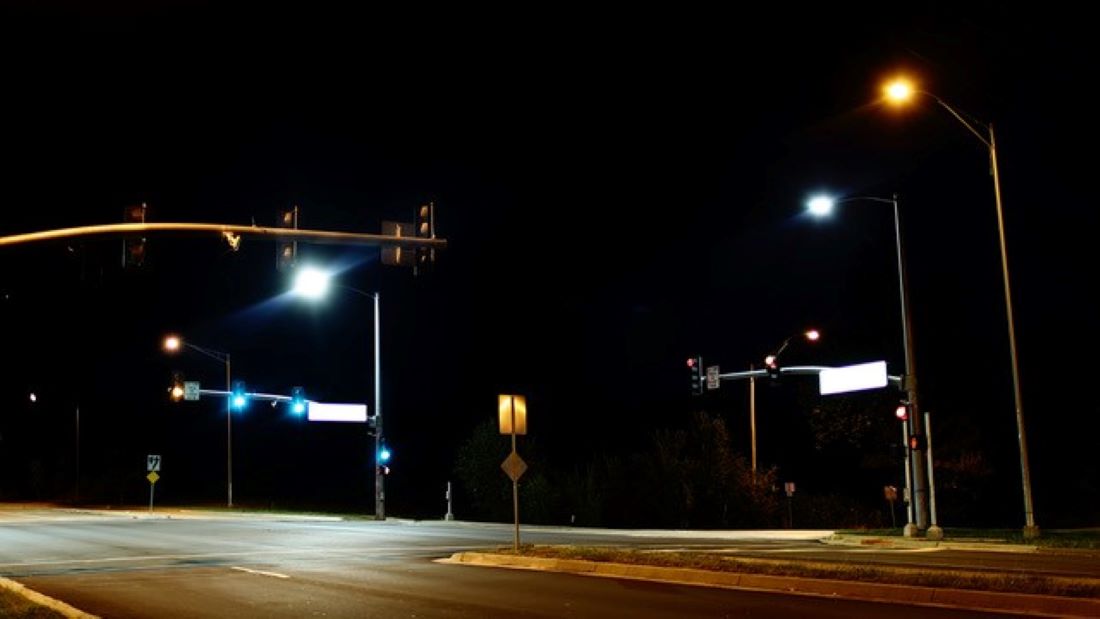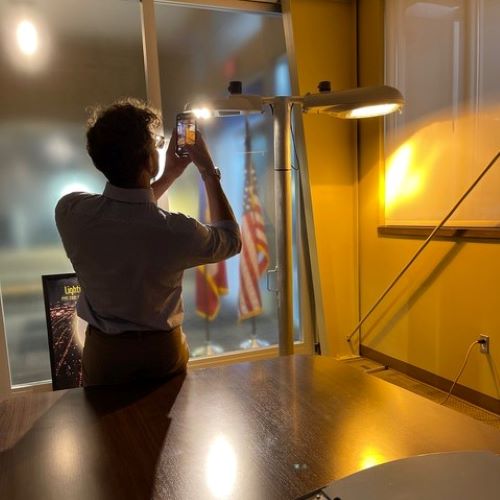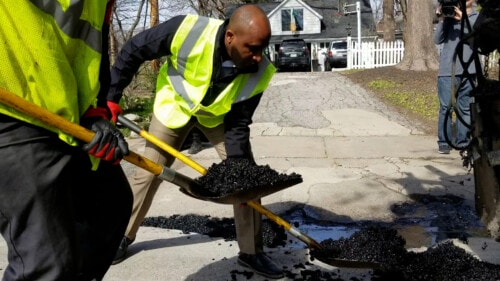From Streetlights to Potholes: A New, Tech-Savvy KC Emerges Solving Problems With Science
 LED streetlights consume less energy, last longer and are brighter than traditional streetlights. Here bright new white light LEDs meet up with the orangish lights that use older technology. (Courtesy | City of Kansas City)
LED streetlights consume less energy, last longer and are brighter than traditional streetlights. Here bright new white light LEDs meet up with the orangish lights that use older technology. (Courtesy | City of Kansas City)
Published January 4th, 2023 at 6:00 AM
Without fanfare, Kansas City is erecting a new generation of power frugal LED streetlights that will save oodles of money.
It is using artificial intelligence to get on top of its age-old pothole problems before the pavement has a chance to crumble.
Five hundred megawatts of solar power soon are expected to land at Kansas City International Airport, one of the largest solar projects ever undertaken by an American city.
If you are unaware of this, you may not see the forest for the trees.
Lots of trees.
Crews will be out planting 10,000 saplings over the next three years, particularly in parts of the metro that may not have been shaded since wagon trains rumbled toward the Oregon Trail.
In both subtle and obvious ways, signs abound that Kansas City is not the cautious, slow to innovate city of the past.
While we were hunkered down during the COVID-19 pandemic starting in 2020, Kansas City, Missouri, city officials confronted a daunting challenge. City Manager Brian Platt explained that the city’s leadership knew it would face declining revenues and mounting costs during the pandemic.
They agreed their response would be to not cut services, raise taxes or order layoffs and furloughs.
“The COVID pandemic was a good opportunity to rethink how we were spending every dollar in the budget,” Platt said.
The low hanging fruit was to renegotiate leasing and contracts and rethink staffing levels, he said.
Consider the city’s Neighborhoods and Housing Department, which was in leased space at 4400 Dr. Martin Luther King Jr. Blvd. for $800,000 a year. Those staffers and operations were moved to vacant space at City Hall, Platt said, and “we saved millions.”
But the real story of city transformation in the last few years may be best told through the story of streetlights and potholes.

LED lights — light emitting diodes — use less electricity and require less maintenance than the traditional incandescent lights they replace.
By switching to LEDs to light our streets, Platt said, the city can save $5 million of the $13 million it pays annually for the lights’ electricity and maintenance.
The high-pressure sodium lights the city is removing must be replaced every five years. In contrast, LEDs last 10 years.
Using less electricity to light the city means there is less atmosphere warming carbon dioxide emitted — 29,000 tons less.
For example, the Arrowhead Stadium parking lot on game days is filled with 19,000 vehicles. Switching out city lighting would cut carbon dioxide emissions equal to taking one-third of them – more than 6,000 cars — off the road for an entire year.
The conversion of city lights to LEDs started in 2022 and should be completed by 2025, Platt said. About 8% already have been converted.
Those sparkling new lights may well be illuminating fewer potholes in years to come as another new city initiative takes hold to repair and preserve 6,000 miles (about twice the width of the United States) of roads in the city, Platt said.
First up, the city has streamlined how motorists can report Big Bertha potholes to the city for fixing via a new “311 app.”
Previously, when potholes were reported, the information was routed circuitously to a supervisor and then to field repair staff. Now that process has been automated, and crews are methodically filling potholes close to each other, getting more done, Platt said.
“Now it is seamless — communications are fast,” he said.
While 8,775 pothole repair requests have come in, 32,000 potholes were filled, Platt said.
“Two years ago, when I got here, it was obvious that there were decades of deferred maintenance,” Platt said. “Asphalt streets have a useful life of 20 years.”
Artificial intelligence (AI) techniques and strategies are being employed to get much more proactive when it comes to roadway maintenance. The city has a special camera on a vehicle driving down each street assessing such data points as the curvature of the street, the color and other characteristics of the roadway, and the presence of potholes, Platt said.
“People are noticing it. We are proud of our achievements here. It is a very aggressive pace, but we need it.”
Brian Platt, city manager of Kansas City
“We are doing it at regular intervals to create a trend forecast on how quickly roads deteriorate and to learn how soon it needs to be resurfaced,” he said. “This data analysis tells us the worst streets.”
In many industries, artificial intelligence allows for proactive maintenance, fixing potential problems before they appear. The city wants to use AI to repair roads so fewer potholes have a chance to appear.
“Over the past 18 months, we’ve resurfaced 10% of Kansas City’s roads and hope the number of potholes will only decrease over time based on the proactive and strategic work of our Public Works Department,” said Sherae Honeycutt, Kansas City spokesperson.
City workers paved 409 lane miles in 2022, triple the normal pace, according to Platt.
“People are noticing it,” he said. “We are proud of our achievements here. It is a very aggressive pace, but we need it.”
Martin Rosenberg is a Kansas City journalist and host of the Grid Talk podcast on the future of energy.




